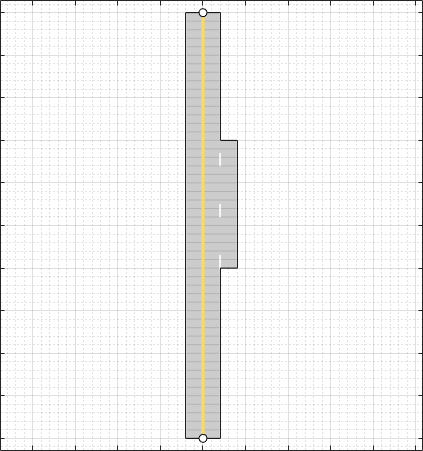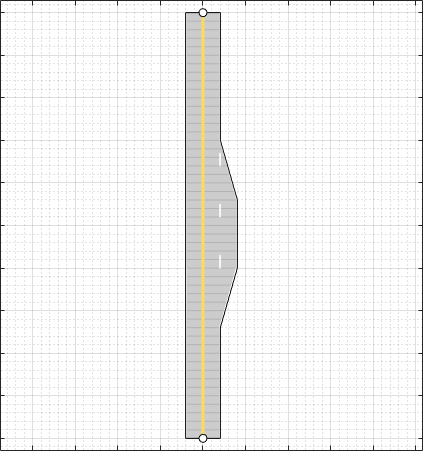Create Roads with Multiple Lane Specifications Using Driving Scenario Designer
This example shows how to interactively create roads with multiple lane specifications using the Driving Scenario Designer app. You can add or drop lanes along a road by defining multiple lane specifications for that road.
This example shows the workflow to create a road with a special passing lane. The passing lane enables slower vehicles to move into the right lane so that faster vehicles can pass uninterrupted in the left lane.

You can also define multiple lane specifications programmatically. For more information,
see compositeLaneSpec.
Open Driving Scenario Designer
To open the app, at the MATLAB® command prompt, enter drivingScenarioDesigner.
Add Road
Add a straight road to the scenario canvas. On the app toolstrip, select Add Road. Then, click at the bottom-center of the canvas, extend the road to the top-center, and double-click the canvas to create the road. To specify precise coordinates for road centers, in the left pane, on the Roads tab, expand the Road Centers section and enter the values for x-axis and y-axis positions shown in this table.
| Road Center | x (m) | y (m) |
|---|---|---|
| 1 | 0 | 0 |
| 2 | 100 | 0 |

Define Multiple Lane Specifications
By default, the road is a single-segment, single-lane road without lane markings. To define multiple lane specifications, split the road into the desired number of road segments and specify different lane specifications for each road segment. The order for numbering the lanes and segments of a road depends on the orientation of the road. For more details, see Draw Direction of Road and Numbering of Lanes and Composite Lane Specification.
Divide Road into Segments
In the left pane, on the Roads tab, set the Number
of Road Segments to 3. By default, the length
of the road is divided equally into the specified number of road segments. You can
edit the lengths of road segments using the Segment Range
parameter that denotes the normalized range for each road segment. Set the
Segment Range parameter to [0.4 0.3
0.3].
Specify Lane Information for Each Road Segment
To define lane specifications for each road segment, from the Road Segment list, select the desired segment. Then, expand the Lanes section and set the Number of lanes and the Lane Width (m) parameters as shown in this table.
| Road Segment | Number of Lanes | Lane Width (m) |
|---|---|---|
Segment 1 (range = 40% ) | [1 1] | 4 |
Segment 2 (range = 30% ) | [1 2] | 4 |
Segment 3 (range = 30% ) | [1 1] | 4 |
This image shows the road after specifying the lane information.

You can inspect or modify the Lane Types and Lane Markings parameters for the lanes in the selected road segment. This example uses default values for these parameters.
Define Connection Between Road Segments
By default, road segments do not have taper when you add or drop lanes along the road. To make the scenario more realistic, specify information for the lanes to taper linearly when adding or dropping lanes between road segments.
Expand the Segment Taper section, select Taper
1 from the list, and set these parameters:
Shape —
LinearLength (m) —
15
Select Taper 2 from the list and specify
the same values for its corresponding parameters.
Note
For two-way road segments, the app determines the position from which to add or drop lanes based on the specified Number of Lanes parameter. When you create multiple lane specifications for a one-way road, the Segment Taper section additionally contains the Position parameter. Using this parameter, you can specify the edge of the road segment from which to add or drop lanes.
This image shows the road after specifying segment taper information.

Next Steps
This example showed how to create a road with multiple lane specifications using the Driving Scenario Designer app. You can add actors and trajectories to the scenario. You can also add sensors and generate synthetic detections. For more information, see Create Driving Scenario Interactively and Generate Synthetic Sensor Data.
To export a road network to an ASAM OpenDRIVE® file, see Export Driving Scenario to ASAM OpenDRIVE File.